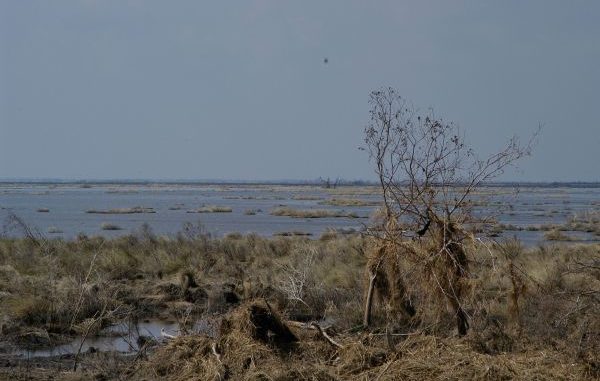
There’s widespread agreement that puncturing levees and diverting sediment-rich Mississippi River water into adjacent wetlands is key to saving the southeast Louisiana coast. Recently, however, debate over the efficacy of diversions has been reopened by disagreement about the extent to which nitrogen from fertilizer runoff damages salt-marsh plants.
Earlier this year, an article appeared in Scientific American that summarized results of an experiment in a Massachusetts salt marsh, a landscape quite different from our delta wetlands, with a 9-foot tide range and a surface affected by freezing and thawing along deeply cut tidal channels.
Ecologists introduced nitrogen fertilizer into water flooding the banks of a tidal creek on every incoming tide. They observed that the banks became unstable and slumped after eight years as the fertilizer stimulated the marsh plants along the creek to grow bigger and more luxuriantly compared to creek banks that were not fertilized.
The theory advanced was that greater plant growth above ground made the banks more likely to be destabilized by high-velocity tidal flows and ice movement.
This is new information that may be useful to managers of the more stable New England coast, but it’s not relevant to sinking Louisiana marshes that are rapidly turning into open water.
The hypothesis that nitrogen in river water might damage the receiving marsh gained attention outside the scientific community when surge and waves driven by Hurricane Katrina ripped up substantial patches of brackish marsh near the Caernarvon diversion — something that also had happened during previous storms.
Similar zones of brackish marsh were torn up by Hurricanes Rita and Ike in the chenier plain, a hundred miles from any river diversion. Concentration of extreme surge and wave energy in this area during Katrina clearly was the main factor, but the damage was interpreted by a few scientists as somehow related to nitrogen in diverted river water.
Carefully controlled field studies coupled with laboratory experiments have been conducted by a number of excellent scientists in the Mississippi River delta, including at Caernarvon.
While some damage to vegetation has been attributed to fertilizer runoff, the research does not support the hypothesis that nitrogen derived from the Mississippi River makes a rejuvenating marsh significantly more susceptible to storm damage.
It’s critically important that the research continue, of course, so that we learn more about how best to manage river diversions to maximize marsh building. But it is also critical that we not allow nitrogen anxiety to further delay the sediment diversions that are absolutely required to sustain what is left of our coast and restart delta building.
With over 1,900 square miles of land lost and counting since the 1930s, Louisiana’s entire coastal ecosystem — and the jobs and communities that depend on it — are at risk. Geologists know that releasing large quantities of sediment-rich Mississippi River water into sediment-starved marshes is our best hope to tame the catastrophic loss. Our challenge is extreme, but we are hardly alone in confronting it.
In coming years, as sea level continues to rise, many places worldwide will face the kind of land loss we are seeing today. Some will also come to know the vulnerability to hurricane surge that frightens our coastal communities every summer. Certainly, Hurricanes Irene and Sandy have shown that these storms — and the surges they bring — are problems not just for the Gulf Coast, but for the entire eastern United States.
We in Louisiana, however, have one great advantage: the Mississippi River and the millions of tons of sand and mud it brings us each year.
A few years ago, nearly a hundred top scientists and engineers from around the country tested combinations of projects proposed to save the Mississippi River Delta and reduce hurricane flood risk. They applied the latest computer models and sea-level rise rates to create the 2012 Louisiana Coastal Master Plan. The plan was discussed in public meetings across the coast, revised after public input, and unanimously adopted by the Louisiana Legislature in May of last year.
Then, in the fall, Congress passed the bipartisan RESTORE Act, which dedicates 80 percent of penalty fines from the BP oil disaster to Gulf Coast states. A large percentage of these fines will go to Louisiana to fund the Coastal Master Plan. The criminal penalties that BP has agreed to are a separate pot of money specifically reserved to create river diversions and restore barrier islands.
With funds becoming available, design work is moving ahead quickly to construct one or more large sediment diversions downstream of New Orleans in the next five years.
There has been resistance to coastal strategies at every turn, and a lot of it is understandable. Oystermen were among early foes of the river diversions because the influx of fresh water is expected to move conditions optimal for oyster cultivation back out closer to the open Gulf, where the best oysters once came from 75 years ago.
Major change is Louisiana’s only hope, and change on this scale is always disruptive. Seizing on the fertilizer issue is convenient for those who want to stall the diversions, but it delays needed recovery strategies — at a moment when time is of the essence.
The fertilizer issue will be closely studied as part of the ecological shift Louisiana must engineer all along its southeast coast over the coming years; but with the shift now attracting funds and gaining momentum, it would be a tragic mistake to stop in our tracks and delay action so urgently needed.
Editor’s note: This is an opinion piece. Paul Kemp is an adjunct professor and John W. Day Jr. a distinguished professor emeritus with Louisiana State University’s Department of Oceanography and Coastal Science.


